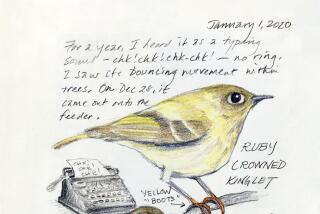Shore Bird Shangri-La
- Share via
MAI PO, New Territories — We are ill-equipped: cheap, lightweight binoculars, one copy of “Birds of Hong Kong,” a couple bottles of water and a few crusts and leftovers that will pass for lunch. Plus faxed instructions regarding driving route, rules and permits for visiting the fabled Mai Po marshes.
Mai Po is a bird sanctuary currently managed and protected by the World Wide Fund for Nature (WWF), the organization that in the U.S. is called the World Wildlife Fund. Just two square miles in size, the preserve is tucked away in the northwest corner of the mainland New Territories that recently, along with the island of Hong Kong, became part of China. Mai Po is about an hour’s drive from Kowloon, the mainland peninsula that reaches out toward the island metropolis.
How important is the preserve? In terms of numbers of species in a concentrated area, most bird experts agree that Mai Po outranks such U.S. birding hot spots as Newburyport-Plum Island in Massachusetts, the Gulf Coast Texas Flyway and Cheyenne Bottoms in Kansas.
One reason is an ample supply of food. About 50 years ago, some of the mangrove thickets here on the edge of Deep Bay were removed, and shallow impoundments were created for shrimp farming. Shrimp still grow in the gai wed--the shallow beds--but except for an annual WWF shrimp feast, the crustacean crop is off limits to humans--available for avian consumption only. In fact, about 80 species of invertebrates flourish here, a smorgasbord for wading birds. Biologists say migrant birds often double their body weights during a two-week stopover in the gai wed.
Also, for birds migrating from China and Mongolia to Malaysia and points south (and back), Mai Po is the only protected wetlands area between Hainan Island and Shanghai. At the peak of the northward flow in April, 20,000 to 30,000 birds of 150 to 200 species arrive at this unique preserve. Birding is good all winter, though, beginning as early as October.
The marshes are a stopover for rare as well as ordinary migrants. Last winter 99 black-faced spoonbills--an endangered species--were spotted here; ornithologists estimate that only 450 are left in the world.
Going where the birds are, about 40,000 birders come here annually, primarily from Scandinavia, Japan and the U.S. Come April, as migratory flocks start north, the dorm accommodations at the preserve most likely will have been fully booked for a year.
No one is sure what Mai Po’s fate will be now that “the hand over” to China has occurred. Even now, a modern housing development is within eyeshot, and another, closer one has been approved. When the tropical haze is not too thick, birders can train their scopes on clumps of not-too-distant skyscrapers across the bay, where frenzied developers have been building since before the hand-over.
But environmentalists are optimistic. Reserve manager Lew Young has hopes that increased contact with his counterparts in China will raise environmental consciousness there. Cross-border cooperation “will be very, very important,” he says. Birds pay no attention to political boundaries, Young points out.
I am a rather indifferent birder. I like to know the names of things, but I don’t keep a “life list” of sightings and seldom go to places where dedicated birders go in order to add to theirs. Still, I follow ecological issues, and I had been hearing about Mai Po sanctuary for a long time. On the Hong Kong-China border. Major flyway. Threatened by development, and possibly by the fact that it now belongs to another country.
Thus I was not among those devotees who come to Mai Po, spotting scopes in hand, just to fatten their bird lists. My son Mark, also a journalist, was posted in Hong Kong, and I had visited him there before; his apartment overlooking the harbor saved me the stupendous hotel costs that ordinary tourists pay in this wealthy city. Indeed, after seeing the crush of Hong Kong’s sophisticated humanity, I was skeptical that any ecological wonder could exist within the colony.
The World Wide Fund for Nature-Hong Kong (WF-HK) is careful about granting access to the sanctuary, but with a few telephone calls Mark arranged our visit for one morning in October.
*
Best bird viewing at Mai Po is just after high tide, as water recedes and shallows are exposed. Avian migrants have two different habitats to harvest here: the shrimp ponds at high tide and the mudflats of Deep Bay as the waters recede each day. High tide this particular day in Hong Kong is to be 7 a.m. Before sunup we are on the road from Hong Kong Island, through Sha Tin and Fanling, headed toward the former Chinese border. Unused to the Asian landscape, I find it hard to believe that a mecca for birds lies in the midst of auto body dumps, ship container storage yards, dense new residential development and, not far off, veritable cities.
The sun is rising behind us, and bird music is in full decibel as we halt in what Hong Kong residents call a car park. While Mark goes to pick up the permits he has reserved, I unlimber my binoculars and look for one, just any one, of the hundreds of avian singers.
A particularly liquid mini-song is being produced by a black-and-white bird that obligingly perches in full view on a dead tree. A Chinese bulbul! I am thrilled. Less so when I read in our bird book that they are exceedingly common, almost pests around the Supreme Court buildings on Hong Kong Island. Never mind. Bulbuls in any form are a new species for me.
Our bird book has a map of the two square miles of shrimp impoundments and mangroves that constitute the refuge. We know we are on the south end of the shrimp beds, and any right turn will lead us toward the bay. We take a likely one, hearing many birdcalls but, because of thickets of mangroves and giant reed grass, see few birds.
At the end of our path is a low green building bearing a sign telling us how to behave in the “hide.” That’s what American birders call a blind, though much more commodious than your average duck blind. We find we can let down wooden shutters, sit on benches, and prop our elbows on a convenient shelf decorated at intervals with a chart identifying 30 or 40 species we are likely to see.
The first blind we come across is as big as a bunkhouse: two-storied, with long views. With a powerful spotting scope, a real birder might add significantly to his or her life list just sitting here. Our miserable binoculars do us little good, though we admire some white great egrets, whose color and size make them unmistakable.
I see a flash of brilliant blue-green wings, far off--the bird lights at the tip of a dead tree. To my bafflement, the smudge I pick out through my field glasses looks white and red. We wait for it to fly again. Wait . . . wait . . . wait. It sits . . . sits . . . sits. Until we look away, and it disappears.
We close the shutters of our hide and walk on. A second blind, one-story, looks east across a shallow inlet. We open shutters to morning sun and almost laugh aloud; nearby sandbars are occupied by so many feathered fellows we scarcely know where to start.
The one on the far shore looks a lot like a great blue heron. Nope. Gray heron. Common here, but as huge and impressive as our great blues. The middle-size wader shaking its rump has to be a white wagtail. Sandpipers. I’ve never managed to differentiate them at home, and can’t here. Pink legs diagnose the black-winged stilt for us, and the little egret, carefully picking its yellow feet out of the water, is a sure bet.
Binoculars in one hand and sandwiches in the other, we spend a long time here. Finally, dazed, we let down our shutters and continue our jaunt northward. A bicyclist overtakes us, wheeling down the dike, the first of only five people we see in a full day here.
*
We are getting better at this. Looking down a canal, we scope dozens of heron, necks protruding, like so many question marks, from dense mangroves. The birds’ vertical, suspicious posture when alighted and their white undersides in flight mark them as Chinese pond herons. Occasionally there’s a hawk displaying a white rump that makes me want to call it a marsh hawk. I’m wrong. It is a female hen harrier. Nomenclature is confusing: There are male hen harriers too.
We come to a chain-link fence and stop to puzzle over our map, which shows a boardwalk extending out to sea. Yes, we are in the right place--and yes, there is a gate. It just looks locked.
Mangrove forests limit our views to either side. But down the boardwalk we get another flash of aqua. The bird lights and sits; we get our lenses on him. It’s the most improbably colored bird I have ever seen: blue, white, red. I’m sure it is rare and exotic. Nope. Common kingfisher. Common!
As we near the blind on Deep Bay, we pass three soldiers in camouflage uniform investigating the mangrove shallows on either side of the boardwalk. Because they’re speaking Chinese, we can only guess what’s going on, but Mark notices a footprint in the sand where the tide has receded.
Flocks and rafts of birds float far out; closer in, dabbling ducks feed. We marvel for a long time as coveys of plovers wheel and dip as if they had one brain. We are frustrated at not being able to identify the ducks; all look alike.
The soldiers enter the blind and look around. When they leave, Mark suggests we follow them out. We feel nervous about possibly being out here with an illegal border crosser. Even now, immigration from the rest of China is carefully controlled, lest a human flood overwhelm the well-heeled former colony. “Somebody trying to enter illegally would love to get his hands on some Hong Kong money,” Mark theorizes.
Back inside the fence, we encounter an English lady with a spotting scope. She wears an Australian field hat with one side of the brim turned up, and wants to know whether the tide is out yet. I ask about her scope, and she offers to let us take a look. There are no birds to be seen, so she focuses in on a skyscraper in China. Back on the “scrape,” she says, there are cormorants, spoonbills, avocets. We’re not sure what a scrape is, but as we cut south across the dike we find a blind overlooking shallows filled with wading birds. This has to be it.
The cormorants stand in the water atop stubby, fat duck-legs, looking like they’re cut off at the knees. Their up-angled beaks give them away. Our meager optics just manage to reveal the long, spatulate bill of the European spoonbill, a more common relative of the endangered black-faced spoonbill. We’re again confronted by innumerable pipers we can’t pin down. Tired and a little cross-eyed, we look at our watches and are astounded to find it’s well past noon.
The exit route takes us past a nature center that is under renovation. There’s also a park-like area populated by captive birds. Benches and signs make this area accessible to novices; we should have started here. We learn the dabbling ducks we couldn’t identify are in their non-breeding “eclipse” phase, during which the sexes look alike.
We stop at the shop to pay our fees. I resolve to buy some decent binoculars. Maybe a spotting scope.
(BEGIN TEXT OF INFOBOX / INFOGRAPHIC)
GUIDEBOOK
Birding in China
Getting there: You need permission to visit the Mai Po preserve; don’t just arrive. With permission, the World Wide Fund for Nature--Hong Kong (WWF-HK) will fax driving directions. Allow about an hour from the central city, 45 minutes from Kowloon.
An easier way to go is to take the clean, modern Mass Transit Railway (MTR) from the central city to Kowloon. From there, take the Kowloon-Canton Railway (KCR) toward the border at Lo Wu. The train reaches your stop, Sheng Shui, in 33 minutes. Mai Po is 15 minutes by taxi from Sheng Shui.
Where to stay: The following, in three diverse price ranges, are among generally recommended lodgings:
Peninsula Hotel, Salisbury Road, Tsim Sha Tsui, Kowloon; telephone 011-852-2366-6251. Rate: about $450, including tax, for the most basic room.
Luk Kwok Hotel, 72 Gloucester Road, Wanchai; tel. 011-852-2866-2166. Rates start at about $260.
YWCA, 1 Macdonnell Road, Central; tel. 011-852-2877-3737; about $135.
Mai Po Preserve: One way to visit Mai Po is with a birding organization, such as the National Audubon Society. WWF-HK prefers that visitors join its guided tours. Whether with a group or individually, advance permission to visit is required. Contact WWF-HK, 1 Tramway Path, Central, Hong Kong; tel. 011-852-2526-4473, or e-mail [email protected].
The best alternative for U.S. visitors may be to go during the week. A one-day weekday pass costs about $13 and gives free access to the entire reserve, 9 a.m. to 5 p.m. Three-hour guided tours on weekends cost about $10, but are geared for local audiences and generally conducted in Cantonese, although guides speak English and can provide supplementary explanations.
For more information: Hong Kong Tourist Assn., 10940 Wilshire Blvd., Suite 1220, Los Angeles, CA 90024; tel. (310) 208-4582 or (800) 282-HKTA, fax (310) 208-1869.
More to Read
Sign up for The Wild
We’ll help you find the best places to hike, bike and run, as well as the perfect silent spots for meditation and yoga.
You may occasionally receive promotional content from the Los Angeles Times.






